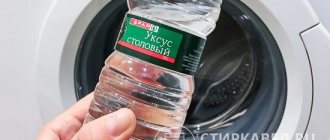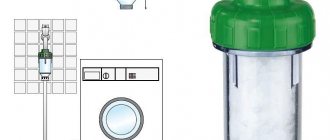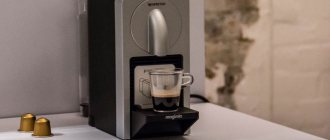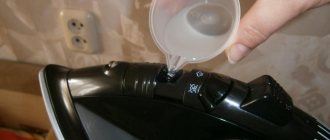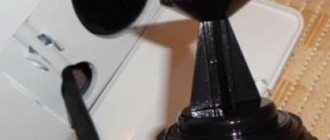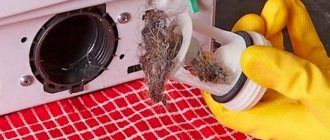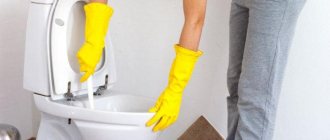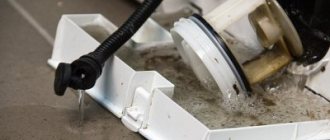Back to list of articles The quality of water supplied to apartment buildings, as well as private sectors, in most cases leaves much to be desired. This forces residents to purchase cleaning products. At the same time, the main filter stands out noticeably, which effectively eliminates various mechanical impurities and suspensions. It’s true that they cost the right amount in stores, which is why some people prefer filter jugs.
But over time, the need arises to think about how to clean the filter for soft or rough water purification. And how to do this? And is it even possible to do this?
How can you tell if your device is clogged?
These devices are used to remove large impurities :
- scale;
- rust;
- mud.
Therefore, they are called “mud collectors”, and the particles retained by them range in size from 20 to 500 microns.
As a rule, the mesh filter element of the coarse filter consists of cells measuring 200 - 300 microns. Consequently, particles with smaller sizes pass through pipes, ending up in household appliances and faucets.
If other filters with finer filters are additionally installed, they may also become clogged.
For example,
the mesh aerator at the end of the faucet spout (gander) often becomes clogged , reducing the intensity of water flow.
You can verify this by turning on the water on several faucets. If water does not come out of all copies, then the problem is not in them. Having found out that the mixer aerators are in order, and water flows through the risers in normal mode, you should recognize the fact that the coarse filter is clogged.
Important. Before you do anything with your plumbing, you should go to your neighbors, up or down the riser, and find out how things are with the water pressure.
You also need to keep in mind that these devices (prefilters) are often sealed together with the meters , so it is not always possible to simply remove the device.
Detergents
When servicing system elements, gentle cleaning is carried out.
To clean water filtration elements, it is advisable to use non-abrasive, non-aggressive detergents with a degreasing effect, for example, dishwashing liquid. Plastic flasks, metal and plastic cartridges can also be washed in the dishwasher. Do not use cleaning products containing STEAM in a dosage of more than 5%, chemical mixtures, or metal brushes and scrapers.
You can often encounter the problem that using only detergent, plaque from the walls of the flask or cartridge is not washed off. This may be the so-called limestone, which is found in greater quantities in modern plumbing systems. This problem can be easily eliminated by using food vinegar or citric acid. The stainless steel cartridge must be placed in a tribasic carboxylic acid solution for 1-2 minutes, then rinsed thoroughly with water and dried. The plastic cartridge can be washed with 9% vinegar, rinsed and dried or wiped. The filter flask is filled with acid and left for 2-5 minutes; after this procedure, all limescale dissolves (an alkali quenching reaction occurs in an acidic environment).
Preparing for cleaning
If you have time to go to a plumbing store, do not neglect this opportunity. Conventional filters are inexpensive - about 150 rubles, but how cleaning will take place is unknown. Therefore, having a spare device will be useful.
The filter element, although subject to cleaning, is also advisable to have in stock. And the gasket under the device plug sometimes sticks to the body and breaks.
Therefore, the shopping list will look like this:
- a filter similar to the device that is clogged (it is advisable to photograph the old one);
- spare filter element;
- gasket for the plug of the flask into which the mesh is installed;
- FUM tape or sanitary linen;
- Rust remover - WD-40, kerosene or car brake fluid (optional).
Before you go to the store, it's worth looking at what parts and tools are available - at home or in the garage. Your shopping list may change significantly.
Required tools:
- lever adjustable wrench (“gas”, “pipe”, “Swedish”);
- a straight adjustable wrench or a suitable open-end or socket wrench;
- double-sided screwdriver;
- pliers.
You may also need a gas burner or a powerful hair dryer. But, since they are not available in every household, they will be replaced by a gasoline lighter.
Some useful tips
Finally, a few tricks. With their help you can extend the life of the filter.
- The cartridges of some types of filter jugs consist of a special resin - cation exchange resin. Under no circumstances should it be allowed to dry out. To do this, you just need to use your filter constantly.
- It is better not to wait until the jug is completely covered with plaque. Regardless of the rate of its formation, it is advisable to treat the vessel in any way approximately twice a month.
- If a paranitic gasket is used on the filter in front of the meter, then the housing and plug must be preheated. For this purpose, you can use boiling water or a gas burner.
That's all the tricks. As you can see, there are many ways to clean filters, and they are quite affordable. You just need to take care of your device so that it does not fail longer.
Instructions
There are three types of devices that carry out rough water purification:
- standard flow-through mesh filter (oblique or straight);
- device with direct or reverse manual washing;
- cassette (cartridge).
Attention. Each of them has its own design features, therefore, they are cleaned differently.
The most common is the standard version, and it is its cleaning that usually causes difficulties.
How to disassemble and in which direction to unscrew?
Before disassembling you should:
- prepare a container for draining the remaining water from the disassembled filter;
- collect clean water in reserve;
- close the required valve at the inlet;
- release remaining pressure in the system by opening the mixer tap.
Disassembly should begin by removing the seal, the wire of which is threaded through the eyelet on the filter plug. If you do not want to pay for sealing, you can try to carefully disassemble the seal while maintaining its integrity.
It happens that after assembly it is impossible to see any difference. However, there remains a possibility that the inspector will notice it . In this case, penalties cannot be ruled out. Therefore, the seal is usually simply torn off, and then a specialist from the management company is invited to install a new one.
Now you need to unscrew the filter plug. There is only one there, so you can’t confuse it, it’s just important to understand which way to unscrew it. The filter housing must be firmly grasped with a gas wrench, and the plug must be grasped with an adjustable, open-end or coupling wrench.
You shouldn’t pull with all your might with the key , as you can dent the edges on the plug or damage something else. This is especially true in cases where the water supply is not made of steel:
- copper,
- polypropylene,
- metal-plastic,
- PVD.
Reference. For a gas wrench to work effectively, its lever must be positioned in the direction of the applied force.
Common reasons why the plug does not unscrew:
- Rust coating of threaded connection. This happens if the filter housing or plug is made of ordinary steel. To solve the problem, apply WD-40 or its equivalent to the rust and leave for 10 minutes. If this does not help, you will most likely have to unscrew the entire filter.
- Sticking of paronite gasket. There is only one way out of this difficulty - strong heating of the plug with an open fire.
To do this you need:
- open the mixer to release steam;
- make sure that there is no danger of heating for plastic parts of meters and other elements;
- heat the plug to 150 - 200 degrees, determining the degree of heating by the boiling of the water.
Unscrewing is done in a counterclockwise direction . There are no standard filters with a “left-hand” thread. After taking available measures, the plug will most likely unscrew. If not, then you will have to unscrew the entire “mud trap”.
How to rinse?
The filter element, in the form of a rolled mesh, can be made of metal, PVC or fiber (fiberglass). This is important for its removal from the flask and subsequent purification.
As a rule, only the metal mesh is reinstalled . But this component sometimes becomes so clogged that it can only be removed with a screwdriver.
Dirt should be removed not only from the filter element, but also from all accessible surfaces of the filter housing. It would be a good idea to treat them with WD-40 or an equivalent.
Then you need to open the main tap, replacing the container. Particles remaining inside the housing will be washed away by the flow of water. The mesh, as well as the plug, should be thoroughly washed with an anti-corrosion agent and water .
Important. When working with a screwdriver, you need to remember that additional grooves and scratches reduce the service life of the plumbing product.
Assembly
If, as a result of the measures taken, it was possible to maintain the integrity of the filter element, you can reinstall it. If dents or breaks occur, a new mesh should be installed. The gasket under the plug is usually also new.
If there are doubts about the long service life of the gasket, you need to wrap FUM tape or flax (tow) around the threads. It is advisable to lubricate the flax with sealant or technical petroleum jelly. Rewinding is done in the direction of the thread . Excess FUM tape is usually squeezed out on its own, so it can be reeled in safely.
Linen is wound from the beginning of the thread with a thin thread, the thickness of which increases after 2 - 3 turns.
While screwing in the plug, the body of the “mud collector” should be held with a gas wrench. The second key is turned clockwise , without excessive force. If the rotation is too tight, there are more windings than needed. In such a situation, the filter may crack, so the winding should be rewound.
Occasionally, the plug may not fit the thread. Then they unscrew it and screw it in again, checking the integrity of the winding.
After completing assembly, you need to check the tightness of the product. To do this, you need to wrap the joints with toilet paper and open the main tap. With normal viewing, you can do without paper.
If water drips, close the valve and tighten the plug without applying excessive force. If the result is negative, you will have to unscrew it, correct or change the gasket, or rewind the winding.
Removing contamination from the pitcher filter
Special purification systems are quite expensive, although they allow you to purify water in an apartment or house with high efficiency. But not everyone has such funds, and therefore the solution would be to purchase a jug from the manufacturer Aquaphor or Barrier. Inside it is a replaceable cartridge, which is usually changed every three months. Fortunately, it is not so expensive and therefore its purchase will not greatly affect the family budget.
But, despite the affordable cost, the filter can be washed and thereby further increase its service life. After all, situations are different. To do this, you should use one of two proven methods.
Method one - using salt
For obvious reasons, it is no longer necessary to turn off the supply of cold and hot water. But first you need to prepare a cleaning solution. To do this, take the salt itself in the amount of two teaspoons per glass of water (200 ml). To dissolve it, you need to mix everything well.
The resulting solution must be poured into the filter cavity and wait until it begins to pour out of it. Accordingly, before cleaning the filter, you should prepare in advance a suitable container into which the liquid will drain.
To increase the cleaning efficiency, it is worth re-filling the remaining liquid that has spilled from the filter. It also makes sense to prepare a little more solution, increasing the amount of salt:
- 2 cups – 4 tsp;
- 3 cups – 5 tsp;
- 4 cups – 6 tsp. etc.
After washing, the filter is ready for further use. Just first rinse it well under running water to avoid the taste of salt.
Method two - cutting off the cap
There is also no need to turn off cold and hot water, as well as additional devices and equipment. All that is required is to remove the cartridge from the jug and then cut off the cap. Underneath there is a mesh, which should be rinsed well with boiled water.
If necessary, you can pass a saline solution through the filter, the preparation of which has already been discussed above. Despite the loss of the cap, the cleaned cartridge is suitable for further use for a long period of time. It is also advisable to clean the mesh periodically every three months.
If you still have doubts about how to clean the water filter or have no desire at all, then the best option is to buy replacement cartridges.
Prevention
A conventional coarse filter, as a rule, is not installed in an easily accessible place. Therefore, preventative cleaning is difficult. Moreover, its design is designed in such a way as not to allow dirt to pass through, even when it is completely clogged. And the degree of clogging is often determined by the decrease in the intensity of water supply from the mixer.
Attention. If the mud trap is easily accessible and there is no seal on it, then preventive cleaning should be done once every 6 months.
However, the manufacturer recommends cleaning models that provide pressure cleaning (water pressure when opening the valve) or cassette samples at least once every six months . But such specimens often have a transparent body, which helps to visually determine the degree of “clogging” of the filter.
Washing stages
To perform the cleaning process efficiently, the following steps should be followed:
Before dismantling parts of the system, it is necessary to shut off the water supply.
- Turn off the water and drain it from the system by opening the taps.
- Carefully remove the flask and water filter from the system.
- Remove the contents of the filter, remembering the sequence of elements.
- Rinse individual elements, clean and polish the walls of the flask(s) and cartridges.
- Dry the components of the device to avoid corrosion of metal parts.
- Assemble the filter in the correct sequence, mount and start the system.
You should not perform the above procedures yourself in two cases:
- If the filter model and configuration is unknown, there is no information about the material from which the cartridge and system parts are made.
- The filter housing is solid or sealed; there is a high probability of damage to parts during disassembly.
If you carefully monitor the condition of the filtration system and promptly clean or replace all its components, the quality of water in your home will always be at a high level. You should not skimp on the resource and its care, then the device will bring benefits, freshness and help take care of the health and condition of the body.
Resin regeneration technology: how the ion exchange resin in the filter is restored
Ion exchange resin is small amber beads that convert magnesium and calcium ions into sodium ions. Thus, the water becomes less hard and scale does not form on household appliances.
Knowing the water hardness indicators, you can predict the approximate life of the resin cartridge. To do this, the capacity indicator is divided by the water hardness indicators, expressed in mEq/liter.
The absorption of magnesium and calcium ions is a reversible process. If there is an excess content of sodium ions, the situation will be the opposite, that is, the release of magnesium and calcium ions and the absorption of sodium ions will occur.
To avoid this, they resort to so-called regeneration, that is, restoring the functions of the ion exchange resin so that it can serve your filter for some more time.
How to filter moonshine through a water jug
Recommendations:
- To obtain a distillate of the highest possible quality, it is advisable to use this method before the second distillation, but you can also filter the finished drink;
- pitcher cartridges are not suitable for cleaning mash, wine, liqueurs, other drinks and fruit moonshine (part of the aroma disappears);
- most moonshiners use three brands of water filters: Aquaphor, Barrier and Geyser, since these are the most common systems;
- the simpler the cartridge (usually called “classic” or “standard”), the better the result;
- It is advisable not to combine the purification of alcohol and drinking water, but to purchase a separate cartridge for moonshine.
We suggest you familiarize yourself with How to preserve rose planting material (cuttings) before planting
What is the difference?
Household water filters differ not only in their shape and installation system, but also in what substances are used to make the cartridges:
- “Aquaphors” use a special “Aqualen” system. The cartridge is made of special fibers, which provide high-quality cleaning.
- In Barriers, the filter itself is made of ion exchange resins and activated carbon, which is a very good sorbent. In addition, during the manufacturing process, activated carbon is treated with silver, which prevents the growth of bacteria even if they enter this environment.
